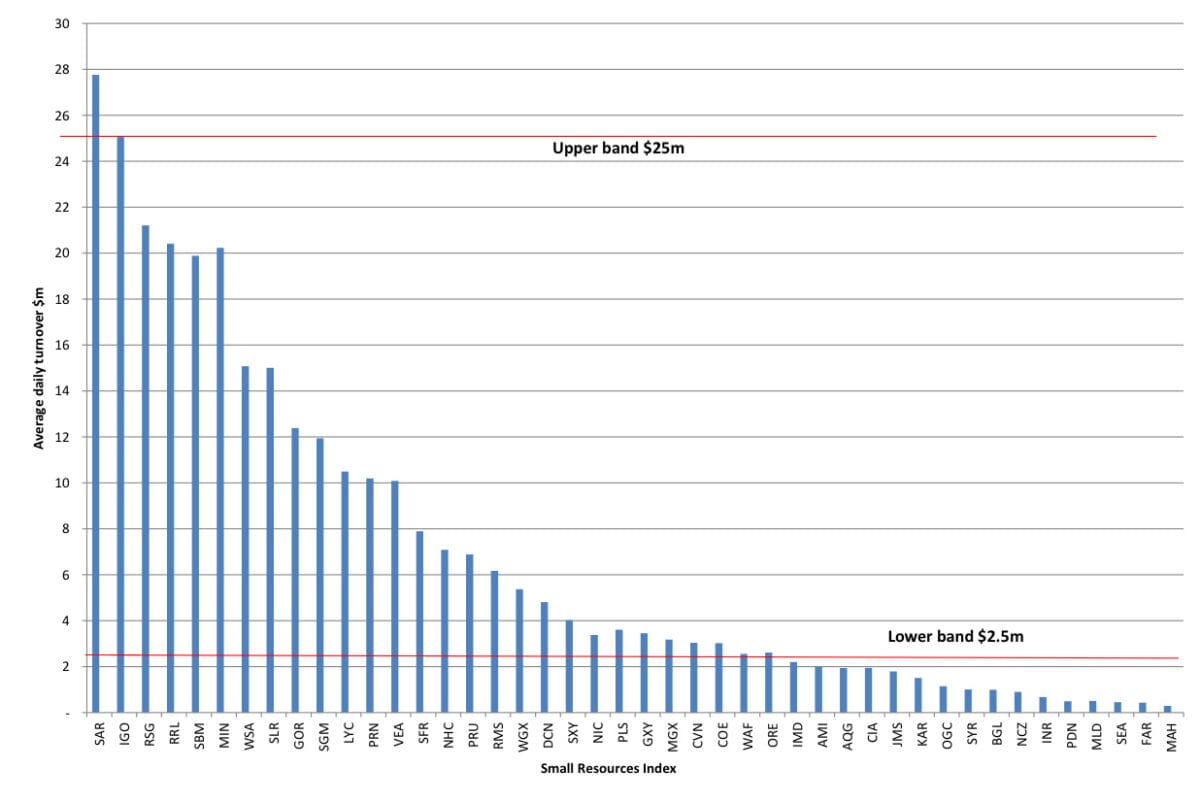First, who are IFM?
IFM Investors was established by all-profits-to-members Australian superannuation funds and manages AUD 152 billion in funds across infrastructure, listed equities, debt, and private equity. It manages AUD 44 billion in equities, and is the second biggest manager of equities in the Australian market, with a full range of capabilities from active/passive, long/ short, large/small and domestic/global. Of the AUD 44 billion in Funds Under Management, the vast bulk are proprietary index and quant-based strategies to deliver index or enhanced index returns on predominantly large cap equities. We also have dedicated teams at the active end of the risk return spectrum, including long-only Small Cap and Australian Core Equities products.
What Do We Look For in Miners/Explorers?
We look for five things: quality, liquidity, a pathway to rerating the environmental, social, and corporate governance (ESG) compliance and portfolio fit.
1. Quality: Ugly Ducklings Welcome
Naturally, everyone loves companies with long-life, lowcost, high-quality assets and strong management teams in commodities with good fundamentals, domiciled in Tier One jurisdictions. These companies offer sustainable throughthe- cycle advantages. Needless to say, they tend not to come cheap!
The more subtle part of the quality analysis is not what we see today, but what is coming. To use a football metaphor: you need to pass the ball not to where the player is, but where they’re going to be. It’s important to identify economic sensitivities around grade and recovery rates, inflection points in strip ratios, where the funding pressure points are, and the timing of when assets flip from being cash consumers to cash generators (if ever!).
Also, sometimes the opportunity is not necessarily obvious. A great example is the Newmont/Buenaventura-owned Yanacocha mine in Peru, which has a reserve grade of only 1g/t and is located at 4000m altitude in the Andes. It’s a pretty daunting prospect on paper. However, from 2000 to 2005 that mine averaged production of 2.6moz per year (peaking at 3.3moz in 2005) at cash costs of only USD 100/ oz. During that time, Yanacocha had a strip ratio of less than 1:1 and achieved recoveries of 70 percent – all from heap leaching! Sometimes it’s not just about grade.
Of course, things can change overnight on exploration success. Our mandates do not require a company to have a JORC compliant resource for us to invest, and we can take a view on exploration upside and district potential.
Finally, good management teams are key. Things don’t always go to plan in mining (to put it mildly!), and it is worth paying a premium for companies to whom we can outsource those sleepless nights.
2. Liquidity: A Brutal Reality
A primary consideration is liquidity. In these volatile times, it is important to maintain an ability to tilt the portfolio, or indeed to liquidate positions, as required, in a reasonable timeframe. With 50 stocks in a USD 1 billion portfolio, the average position size would be USD 20 million. Taking into account position sizing and benchmark weights, position sizes can range from USD 5 million (as a practical minimum) up to USD 50 million. Assuming we trade 20 percent of the market, this implies a target average daily value traded of between USD 2.5 million and USD 25 million to trade a position in 10 business days. As Figure 1 shows, the majority of mining stocks in the Small Ordinaries Index are closer to the low end of this liquidity range.
Fig 1.

3. Get the Rerates, Avoid the Derates
Explorers and miners are familiar with the Lassonde Curve, the chart which conceptualises the risk and value proposition of an asset as it matures from a discovery to a mature producing mine. In practice though, Degrussa or Nova type discoveries don’t come along too often, and share prices rarely follow the script!
Diversifying from a single-asset company to a multi-asset company is a good way to rerate in our small cap universe. Northern Star Resources (NST) started with the Paulsens gold mine and Evolution Mining (EVN)(now Conquest Mining), began with the Mt Carlton gold and silver mine. Now, both are top 100 companies after numerous successful acquisitions.
Mt Carlton is particularly interesting. That project was stalled because of some tricky metallurgy requiring expensive processing options. Enter Jake Klein, whose experience with refractory ores and relationships with Chinese offtakers from his successful Sino Gold stewardship brought the right thinking to deliver a cost-effective solution. The rest is history.
On the flip side, St Barbara’s Allied Gold deal in 2012 was a derating and near fatal (for the company) event, before its extraordinary rerating from 2015 driven by prodigious cash generation from Gwalia. Getting ahead of these events is the holy grail of investing, although it’s easier said than done.
4. ESG is a Journey to be Embraced
In August this year, 181 CEOs of US-based companies, including JPMorgan Chase, Apple, Amazon, and Walmart, signed a new “Statement on the Purpose of a Corporation”, which affirms that companies have a “fundamental commitment” to all their stakeholders, putting employees, suppliers, and communities on a pedestal previously occupied solely by the shareholder. This notion has already gathered significant momentum in Australia, with ESG an important and growing component of investment analysis. At IFM Investors, for instance, we are proactive supporters of the 30% Club, promoting, as a first step, 30 percent female representation on ASX200 boards. ESG compliance is now simply a ticket to the game (the listed market), and companies should embrace ESG and all it requires sooner rather than later if they want access to listed equity capital. Miners understand better than anyone that people need to go home safely after a day’s work.
That said, we understand that things like majority board independence and perfect remuneration policies take time, as companies navigate the perils of running a real business on limited resources. We will support those who, although currently non-compliant with “ideal” standards of corporate governance, demonstrate a genuine commitment to achieving appropriate balance over time.
5. Portfolio Construction: The Whole is Greater than the Sum of the Parts
A couple of portfolio measures include tracking error (risk) and liquidity (how long it takes to get in and get out of a position). Provided these are within prescribed bounds, there is scope, or a “risk budget”, to dance down the wicket and introduce opportunities that are less liquid and higher risk but higher return to the fund (of which there are plenty in resources). This may include a top-tier asset in a geopolitically higher risk jurisdiction, or a pre JORC resource exploration play. This is to be used very sparingly, but does introduce some early stage opportunities. A current example includes the Victorian explorer Staveley Resources (ASX: SVY).
The Rise of Passive Investing: Silver Lake Case Study
Australian gold miner Silver Lake Resources (ASX: SLR) offers a good example of a fundamental rerating magnified by passive investing. On 14 November 2018, SLR announced an agreed merger with Doray Minerals (ASX: DRM) for an effective nil premium. In our view, the merger made good fundamental sense. Apart from corporate synergies, comparable narrow vein underground assets, and portfolio diversification, the merger brought cash to the well-operated but otherwise cash-constrained Deflector mine. As shown below (Figure 2), from the start of 2019, SLR strongly outperformed the AUD gold price, the USD gold price, and its peers in the Australian gold equity index, peaking at 170 percent higher in July while the Australian gold peer group was up only 50 percent. Note too, trading volume is a degree of magnitude higher now than 12 months ago.
Fig 2.

To be clear: we think this was a good deal for both parties. SLR has performed exceptionally well at its combined operations in 2019, and a rerating relative to peers is fundamentally warranted.
However, in our estimation, the rerating was magnified by net buying of around 65 million shares from passive investment, which represented around AUD 60 million of value or 9.3 percent of shares outstanding (on a weighted average basis). This is summarised in Table 1. In this analysis, we have only assumed passive buying from ASX indices and the Van Eck gold ETF. We have assumed that inclusion in the ASX300 generates circa 1.5-2 percent of the register in new demand, and inclusion in the ASX200 equates to a further 4.5-5 percent of the register in additional demand. Furthermore, according to Morgan Stanley, since March 2007 inclusions in the ASX200 outperformed the market by +7.1 percent for the period from 20 days prior to announcement up to implementation.
Table 1.

By way of background, Van Eck in the US runs two global gold equity ETFs. The large cap ETF, GDX, was launched in May 2006 and currently has around USD 11.4 billion held in 45 stocks. The small cap index, the GDXJ, was launched in November 2009 and currently has around USD 4.3 billion held in 73 stocks. The index has a 53bp management fee and is designed to give investors globally-diversified exposure to the gold mining sector without stock specific risk. SLR is a member of the GDXJ. Van Eck’s last substantial holdings filing with the ASX for SLR was in November last year at 6.0 percent.
This obviously works in reverse too – if a company disappoints, that buying turns into selling. Van Eck substantial holdings filings (>5 percent) in the Australian miners since the fund’s inception, have been as high as just under 20 percent of the register (takeover territory), so the ETF impact on share prices and liquidity has been profound. The resulting volatility creates significant opportunity for active investors to make money. As the chart (Figure 3) below shows, all you need to do is to get in early and choose where gold is headed. Easy!
Fig 3.

Benchmark inclusion has another benefit aside from passive investing. It puts a company on the radar for active managers. Fund managers typically have an index-based benchmark, requiring them to be a bit more deliberate about not owning a particular company in the index. Unlike a non-index stock, it can hurt their relative performance if it goes up, particularly if it carries a large weighting.
Fundamentals Remain as Important as Ever
Rapid growth in passive and quant investing in all its forms has been disruptive to equity markets. For active managers it has added volatility and widened the gap in valuation between the large and small miners/explorers. But the move into passive investing is perfectly rational: it is an effective way to deploy large and ever-increasing amounts of capital into equity markets while diversifying risk at competitive fees. It helps our clients to get equity-linked returns, while also lowering their management expense ratios. It fulfils a role and is here to stay.
However, passive investment doesn’t deliver alpha. It also doesn’t fund mines and exploration. Active and fundamental investing not only provides the funds to build mines of the future, but, done well, it offers alpha for those investors participating in that end of the market. In doing so, active investing is necessary to ensure the integrity of market valuations and to keep the machines honest!
For the time being, riskier asset valuations are suffering in the face of trade wars and slowing growth. This is a cyclical phenomenon, and part and parcel of ordinary mining cycles. At this point of the cycle, there tends to be money available for those cash-generating companies that don’t need it, but not much for the aspiring developers and explorers who do. The pendulum will swing back, and our job is ultimately to ensure that money goes to the right projects to generate the best returns.












